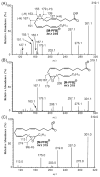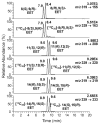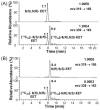Analysis of epoxyeicosatrienoic acids by chiral liquid chromatography/electron capture atmospheric pressure chemical ionization mass spectrometry using [13C]-analog internal standards
- PMID: 20972997
- PMCID: PMC3348553
- DOI: 10.1002/rcm.4760
Analysis of epoxyeicosatrienoic acids by chiral liquid chromatography/electron capture atmospheric pressure chemical ionization mass spectrometry using [13C]-analog internal standards
Abstract
The metabolism of arachidonic acid (AA) to epoxyeicosatrienoic acids (EETs) is thought to be mediated primarily by the cytochromes P450 (P450s) from the 2 family (2C9, 2C19, 2D6, and 2J2). In contrast, P450s of the 4 family are primarily involved in omega oxidation of AA (4A11 and 4A22). The ability to determine enantioselective formation of the regioisomeric EETs is important in order to establish their potential biological activities and to asses which P450 isoforms are involved in their formation. It has been extremely difficult to analyze individual EET enantiomers in biological fluids because they are present in only trace amounts and they are extremely difficult to separate from each other. In addition, the deuterium-labeled internal standards that are commonly used for stable isotope dilution liquid chromatography/mass spectrometry (LC/MS) analyses have different LC retention times when compared with the corresponding protium forms. Therefore, quantification by LC/MS-based methodology can be compromised by differential suppression of ionization of the closely eluting isomers. We report the preparation of [(13)C(20)]-EET analog internal standards and the use of a validated high-sensitivity chiral LC/electron capture atmospheric pressure chemical ionization (ECAPCI)-MS method for the trace analysis of endogenous EETs as their pentafluorobenzyl (PFB) ester derivatives. The assay was then used to show the exquisite enantioselectivity of P4502C19-, P4502D6-, P4501A1-, and P4501B1-mediated conversion of AA into EETs and to quantify the enantioselective formation of EETs produced by AA metabolism in a mouse epithelial hepatoma (Hepa) cell line.
2010 John Wiley & Sons, Ltd.
Figures










Similar articles
-
Quantification of Epoxyeicosatrienoic acids Enantiomers: The development of reliable and practical liquid chromatography mass Spectrometry assay.J Chromatogr B Analyt Technol Biomed Life Sci. 2024 Oct 15;1247:124346. doi: 10.1016/j.jchromb.2024.124346. Epub 2024 Oct 20. J Chromatogr B Analyt Technol Biomed Life Sci. 2024. PMID: 39461018
-
Enzymatic and free radical formation of cis- and trans- epoxyeicosatrienoic acids in vitro and in vivo.Free Radic Biol Med. 2017 Nov;112:131-140. doi: 10.1016/j.freeradbiomed.2017.07.015. Epub 2017 Jul 19. Free Radic Biol Med. 2017. PMID: 28734877 Free PMC article.
-
Cellular lipid extraction for targeted stable isotope dilution liquid chromatography-mass spectrometry analysis.J Vis Exp. 2011 Nov 17;(57):3399. doi: 10.3791/3399. J Vis Exp. 2011. PMID: 22127066 Free PMC article.
-
Targeted quantitative analysis of eicosanoid lipids in biological samples using liquid chromatography-tandem mass spectrometry.J Chromatogr B Analyt Technol Biomed Life Sci. 2009 Sep 15;877(26):2736-45. doi: 10.1016/j.jchromb.2009.03.011. Epub 2009 Mar 17. J Chromatogr B Analyt Technol Biomed Life Sci. 2009. PMID: 19345647 Free PMC article. Review.
-
Isotope-coded ESI-enhancing derivatization reagents for differential analysis, quantification and profiling of metabolites in biological samples by LC/MS: A review.J Pharm Biomed Anal. 2016 Oct 25;130:181-193. doi: 10.1016/j.jpba.2016.04.033. Epub 2016 Apr 30. J Pharm Biomed Anal. 2016. PMID: 27178301 Review.
Cited by
-
Chiral lipidomics of monoepoxy and monohydroxy metabolites derived from long-chain polyunsaturated fatty acids.J Lipid Res. 2019 Jan;60(1):135-148. doi: 10.1194/jlr.M089755. Epub 2018 Nov 8. J Lipid Res. 2019. PMID: 30409844 Free PMC article.
-
Modern Methods of Sample Preparation for the Analysis of Oxylipins in Biological Samples.Molecules. 2019 Apr 25;24(8):1639. doi: 10.3390/molecules24081639. Molecules. 2019. PMID: 31027298 Free PMC article. Review.
-
Vascular Damage, Thromboinflammation, Plasmablast Activation, T-Cell Dysregulation and Pathological Histiocytic Response in Pulmonary Draining Lymph Nodes of COVID-19.Front Immunol. 2021 Dec 13;12:763098. doi: 10.3389/fimmu.2021.763098. eCollection 2021. Front Immunol. 2021. PMID: 34966385 Free PMC article.
-
Stable isotope labeling by essential nutrients in cell culture for preparation of labeled coenzyme A and its thioesters.Anal Chem. 2011 Feb 15;83(4):1363-9. doi: 10.1021/ac1027353. Epub 2011 Jan 26. Anal Chem. 2011. PMID: 21268609 Free PMC article.
-
Methods of the Analysis of Oxylipins in Biological Samples.Molecules. 2020 Jan 15;25(2):349. doi: 10.3390/molecules25020349. Molecules. 2020. PMID: 31952163 Free PMC article. Review.
References
-
- Guengerich FP. Drug Metab Rev. 2004;36:159. - PubMed
-
- Capdevila JH, Falck JR, Imig JD. Kidney Int. 2007;72:683. - PubMed
-
- Guengerich FP. Chem Res Toxicol. 2008;21:70. - PubMed
-
- Bylund J, Kunz T, Valmsen K, Oliw EH. J Pharmacol Exp Ther. 1998;284:51. - PubMed
-
- Hsu MH, Savas U, Griffin KJ, Johnson EF. Drug Metab Rev. 2007;39:515. - PubMed
Publication types
MeSH terms
Substances
Grants and funding
LinkOut - more resources
Full Text Sources
Molecular Biology Databases
